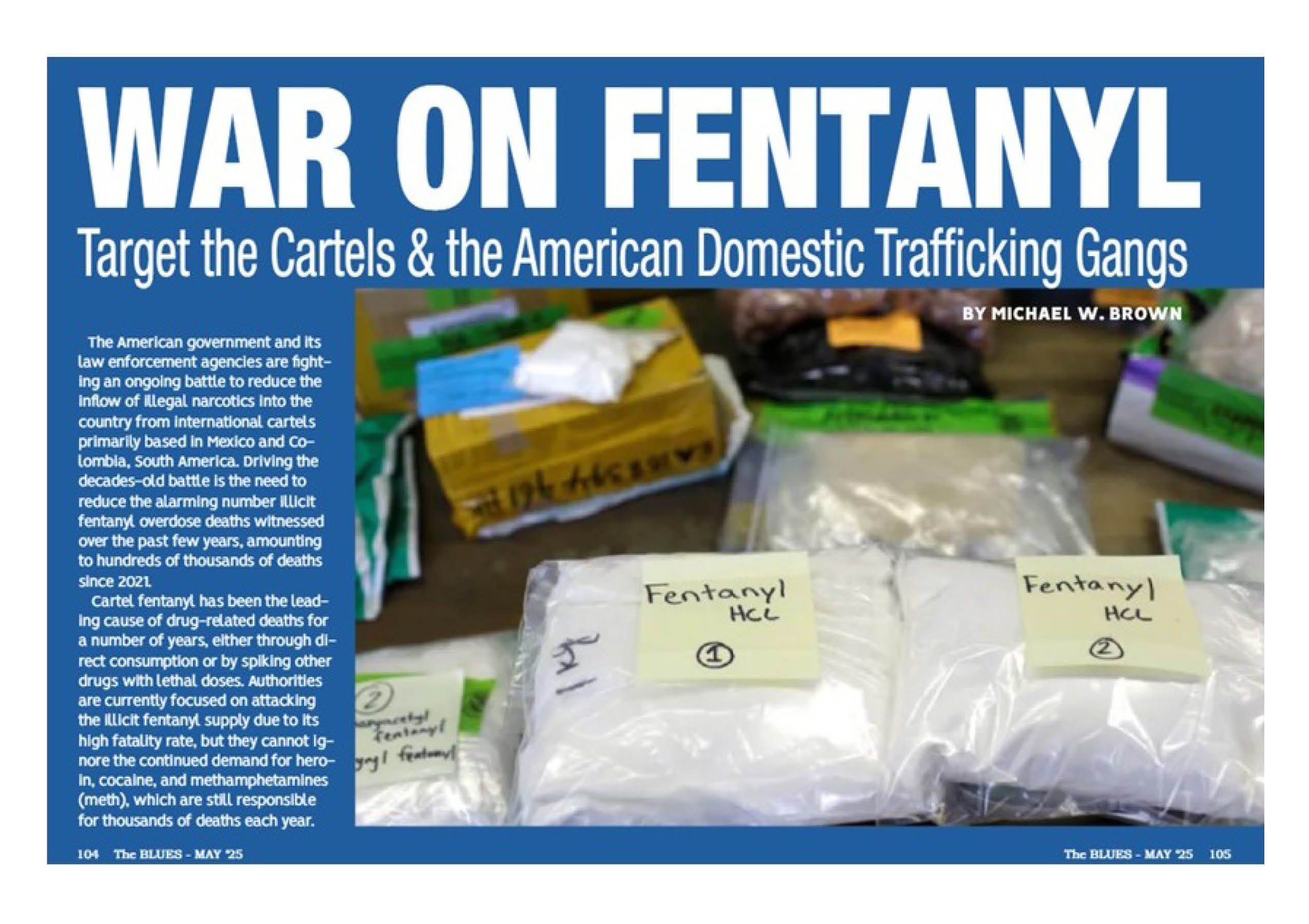Targeting the Cartels & the American Domestic Trafficking Gangs
May 5, 2025

This article first appeared on page 104 of the May issue of The Blues.
The American government and its law enforcement agencies are fighting an ongoing battle to reduce the inflow of illegal narcotics into the country from international cartels primarily based in Mexico and Colombia, South America. Driving the decades-old battle is the need to reduce the alarming number illicit fentanyl overdose deaths witnessed over the past few years, amounting to hundreds of thousands of deaths since 2021.
Cartel fentanyl has been the leading cause of drug-related deaths for a number of years, either through direct consumption or by spiking other drugs with lethal doses. Authorities are currently focused on attacking the illicit fentanyl supply due to its high fatality rate, but they cannot ignore the continued demand for heroin, cocaine, and methamphetamines (meth), which are still responsible for thousands of deaths each year.
The efforts to tackle the inflow of narcotics is laudable. However, federal, state, and local law enforcement agencies cannot do much against internationally based cartels as they face restrictions as to where and how they operate. Domestic drug trafficking organizations, on the other hand, play a crucial role in distributing narcotics for cartels, acting as wholesalers, cutting and packaging the drugs into smaller quantities for sale to the public. Operating within the border of America provides authorities with more power to address and degrade their business.
Focusing on degrading domestic narcotic operations will restrict cartels’ access to the American market, directly impacting their ability to function. Ignoring the domestic gangs will allow the cartels to maintain their easy access to the America market via different smuggling routes, keeping their illicit profits flowing.
President Donald Trump signed an executive order in January 2025 enabling cartels to be designated as foreign terrorist organizations (FTOs). On 19 February 2025, Secretary of State Marco Rubio formally designated eight criminal organizations with ties to Latin America as FTOs.
Domestic criminal organizations and gangs have successfully evaded law enforcement in the past, appearing to operate beyond the law, even in American prisons. However, by designating the cartels as FTOs, law enforcement has a new weapon to use against these well-funded and violent gangs.
Supporting foreign terrorist organizations
The two statutes that will support law enforcement and contribute to the reduction of the domestic drug trade are 18 U.S.C. 2339A and 2339B, which outline the penalties for providing material support or resources to facilitate offenses that a terrorist group may commit.
Targeting domestic traffickers as accessories to FTOs that provide material support and resources to terrorist organizations is within the law and could cripple, or at least, seriously damage the national narcotics supply chain. It will also discourage new entrants because of the harsh punishment associated with supporting FTOs.
Material support does not necessarily mean joining the organization, but simply knowing how that support will be used. In the case of cartel FTOs, trading with them and supporting their weapons sales, human smuggling, and drug-selling activities is classified as material support, a federal offense that can lead to harsh sentences of up to 20 years in a federal penitentiary.
Failing to address the supply chain through these domestic arms of the cartels will fail to mitigate the overdose and addiction rates as the narcotics supply chain remains intact and drugs flow freely.
Prosecutorial challenges and requirements
To achieve the goal of effectively prosecuting domestic drug organizations and degrading their networks, national prosecuting authorities must coordinate their strategy nationwide. They need to develop the same mandatory minimum sentences for dealing in fentanyl, heroin, cocaine, or meth.
According to the DEA, one kilogram (2.2 lbs.) of fentanyl has the potential to kill 500,000 people. Mandatory sentences need to consider statistics like this to ensure gangs know there will be no leniency if caught, and a greater threat to the public will result in longer sentences. Similarly, the smaller dealers that sell grams to users need to face harsh sentences related to the level of their crimes to discourage them from plying their trade.
Minimum mandatory thresholds are critical tools in law enforcement's arsenal because America is facing drug cartels and gangs on its own. The supply chain can only be disrupted within the country as Asian suppliers of precursor chemicals will not stop their trade despite promises made in the past. Similarly, Mexico has yet to act decisively against the cartels and do its part to degrade the fentanyl and other narcotics smuggled over its borders into the USA. America's only option is to tackle domestic organizations as accessories to FTOs.
The strategy will also necessitate increased legal human resources to address the case backlog and manage the potential rise in future prosecutions. There is presently a shortage of people capable of handling all the cases brought to them by law enforcement officers, and this will reach crisis proportions when prosecuting large organizations.
An additional focus area must be the gangs that target African American communities. While this will potentially result in accusations of racism, the facts are that, since 2014, the mortality rate due to overdoses in the non-Hispanic Black male demographic has increased fourfold, outpacing any other demographic in the country. The primary cause is synthetic opioids such as fentanyl.
Communities, particularly those in economically disadvantaged areas, must be central to efforts aimed at removing gangs and their dealers from the streets. At the same time, law enforcement initiatives must be complemented by social programs including providing harm reduction resources, delivering outreach messaging, and educating residents about the effectiveness of drug treatment and recovery support services within their neighborhoods.
Zero tolerance for dealers
Degrading the domestic supply chain requires a zero-tolerance approach – there can be no excuses or second chances. Dealers, whether small or large, must understand they will face harsh sanctions. New York's 'Broken Window' strategy needs to be applied in all drug-related offenses, not only charging perpetrators for drug crimes, but also for supporting terrorist organizations.
America faces a choice: either take decisive action against drug dealing or accept a situation that leads to increased fatalities, worsening inner-city conditions, and rising crime rates stemming from the hopelessness people feel in their circumstances. Being sympathetic is no longer an option, even though there will be an increase in the number of people incarcerated.
With the current administration saving billions in wasted expenditures, the overcrowding problem and the lack of prosecutorial staff could be resolved with a small percentage of the money saved. New prisons with improved rehabilitation policies and more, better-trained personnel will enforce the courts' sentences and assist in reducing recidivism rates.
A similar crisis will hit the state crime/narcotics laboratories. Every narcotic arrest must have the evidence confirmed in state laboratories, which are also overwhelmed. Additional funding for laboratories and skilled personnel is needed to ensure tests and confirmations occur in a reasonable time frame, allowing for faster prosecutions with court-approved evidence.
Preparing law enforcement for enhanced operations
Law enforcement agencies are under significant pressure in the current environment, already facing insufficient personnel and limited access to the latest equipment. If tackling domestic drug trafficking organizations is added to their workload, they will be under even more strain. Given that significant cases like this would take months or even years to finalize, it's clear that these agencies will also need more resources.
Budget allocations in law enforcement must be increased and carefully managed across all areas, from local police to state and federal agencies. The list of potential funding needs is extensive, but the most critical priority is hiring more appropriately trained and equipped personnel, while providing additional training and more advanced equipment to current operatives.
As mentioned, state and federal authorities can finance these budget initiatives by redirecting funds from its current cost-saving measures to law enforcement. By leveraging these savings, stakeholders can work toward more powerful law enforcement operations without further burdening the taxpayer.
Law enforcement agencies have a long history of dealing with criminal organizations, so the tactics and processes required are well known. Enhancing cooperation and integrating operations across departments is crucial to effectively addressing these challenges. By assigning a single, integrated-agency task force to manage each case, authorities can avoid unnecessary overlaps or gaps in the process while ensuring different departments do not waste time and resources on the same investigation.
Similarly, sharing skills and investigative processes could improve all agencies' abilities, streamlining the process from discovery to prosecution. Coordinated intelligence operations must also be enhanced to address the gangs' distribution in cities and states, and to ensure that even the smaller dealers are included in the net.
Law enforcement should have the latest presumptive analysis technology at hand, particularly at a street level, to prevent police, laboratories, and prosecutors from wasting time on cases involving incorrectly identified substances. These systems are easy to use and can very accurately identify suspicious substances on the scene in seconds, ensuring they only send genuine narcotics for analysis at state laboratories.
Disrupting cash flow
Money laundering operations will also be targeted, forcing the gangs into making more mistakes as their usual path to 'cleaning' their profits is shut down. With laundering operations restricted, the gangs and cartels will be compelled to either hoard cash or smuggle large quantities of cash out of the country to nations with more relaxed banking rules.
Having too much cash can be problematic for criminal organizations, as was evident during Pablo Escobar's reign, when he would hide cash in the walls of his houses or bury it. His brother estimated that about $2.1 billion was lost annually due to rats eating it or the money being damaged by the elements.
A final arrow in law enforcement's quiver will be the justice system, where updated plea-bargaining rules for specific types of narcotic crimes could be implemented. Plea bargaining is not ideal when dealing with people and organizations associating themselves with FTOs, but deals will have to be made to streamline prosecutions and ensure the bigger fish end up behind bars.
With mandatory minimum sentences for providing 'material support to a terrorist organization', the chances of suspects cooperating as prosecution witnesses increase dramatically. This will improve intelligence gathering and strengthen the prosecution's case against high-value targets.
Embrace the first step and expand
Designating certain cartels as FTOs is only the first step in reducing drug trafficking, and the other crimes cartels are involved in. Their primary operations are in different countries that may not be willing to tackle these organizations, leaving America with only one option. The cartels' American associates must be eradicated by charging them as accessories to FTOs.
The human, weapon, and narcotics supply chains used today have had years of almost zero consequences for their crimes, allowing them to optimize their operations. America needs to fight back with integrated city, state, and federal processes that tackle these criminals as terrorist associates, from the gram dealers on the streets through to the domestic gangs and their money launderers. A few sporadic arrests won’t do the job.
The only sustainable route for law enforcement to take is to significantly degrade the cartels and their associates in America and to attack them as FTO supporters, discouraging minor criminals with harsh sentences and removing the gangs from society for decades. This will lessen the easy availability of drugs and provide communities with the time to improve social care and reduce the demand side of the supply chain.
Views expressed in this article are the opinions of the author, and do not necessarily reflect the views of Rigaku Analytical Devices.


Contact Us
Whether you're interested in getting a quote, want a demo, need technical support, or simply have a question, we're here to help.
